Two of Ireland’s foremost botanical experts, Dr. Noeleen Smyth and Dr. Darach Lupton share their global plant journeys so that Ireland’s next generation of plant lovers might broaden their perspectives
FROM PIERIS TO PITCAIRN
DR NOELEEN SMYTH
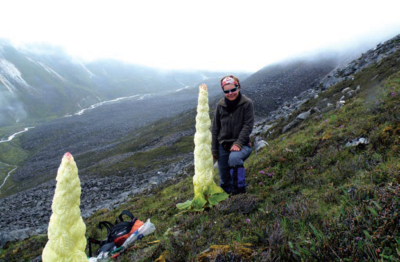
I got my first job in horticulture in Doran’s Heather Nursery in Kildare, the colours, exotic names and varieties astounding to my young eyes, but when I really look back the journey into plant obsession and interest started much earlier. My Nan was a plantswoman and had a lovely garden full of beautiful shrubs and flowers. She would root plants in jars of water
sitting on the window sill and the smell of southernwood (Artemisia abrotanum) brings me back to those happy days with her and my aunt. Nan brought some sneaky slips or new
plants back with her from every journey she made.
The garden was adjacent to an area of peat, clay and gravel hills, with slopes sweeping into the once amazing dome of the Hodgestown bog. It was on these slopes, meadows and on the margins of the boglands that I had my first experience with wild orchids (Dactylorhiza spp. Plananthera spp. Listeria spp), sundews (Drosera spp.), wild strawberries (Fragaria
vesca), flag iris (Iris pseudacorus) and frochan berries (Vaccinium myrtillus). Little did I know that I was getting to see a wide variety of Irish plant habitats in one space.
Our school sat next to the horticultural oasis of Coolcarrigan Gardens, and nature walks with our teacher brought me face to face with Pieris ‘Forest Flame’. I still remember being awestruck by the colour. While my school friends and I planted a leylandii hedge at the boundary of our school my friend Yvette and I named ours “Freddy Evergreen”! Well, Freddy Evergreen and his buddies have long since fallen out of horticultural favour, since they started to grow a bit wild and our Freddy has since been felled. The bog pools and humps of Hodgestown bog have become a Bord na Mona peat harvesting station and a brown desert, and my Nan, her garden, and the land have since passed on. But Coolcarrigan Gardens and Doran’s Heather Nursery continue to thrive to inspire the next generation.
Plants have taken me to every corner of the globe. My first job after qualifying with a Diploma in Horticulture from the National Botanic Gardens was in the exotic Talbot Botanic
Gardens at Malahide Castle. Here I was given a glimpse of the southern hemisphere and its wondrous exotic plants. Little did I know that this job paved the way for many plant journeys and explorations to come. I returned to the National Botanic Gardens to work as a gardener and that’s when the opportunity to travel to see plants arose. The Botanic Gardens Education Society organised regular trips to gardens around Dublin in the summer
evenings and around the country and even abroad in those days. I got to see Helen Dillon’s amazing garden in Ranelagh, the tree ferns in Glanleam Gardens in Valentina and Himalayan blue poppies in Scottish gardens all in the one year.
I couldn’t get enough of such diversity, the amazing colours, and wondrous sights, with inspirational plants people leading the way.
It was also at the Botanic Gardens that the first opportunity to travel on a Glasnevin expedition arose with Brendan Sayers, the glasshouse foreman. Brendan had taken over the orchid collection, I had an interest in orchids, and with an ex-Glasnevin student Brendan O’Donoghue living and working in Belize, the opportunity arose with funding from Botanic Garden Trust Fund and the Merlin Trust to mount an expedition to Belize in Central America to collect orchids. Horticulture, what a profession! I was in heaven with a real job that offered me the chance to be a child again and go exploring.
Once I got to see the rainforest – a jungle, a living, breathing, exotic wonderland – there was no going back to deadheading. I wanted to explore and discover new plants as a career and signed up for botany at Trinity along with one of my fellow expedition teammates Darach Lupton, my brother in blossoms.
Since then it has been a whirlwind of places and plants. The Royal Horticultural Society, the Merlin Trust, the Stanley Smith Trust, the Mohammed Bin Zayed Trust, the UK Overseas
Territories Environment Fund, the Irish Research Council, the Heritage Council, National Parks and Wildlife Service have all funded various plant expeditions and missions. It turns out that combining horticulture and botany is a very good idea.
The unique combination of horticulture and botany led me to set up a nursery on one of the remotest islands in the world, Pitcairn Island, where I saved an endemic species from
extinction and introduced it into cultivation, the yellow fatu (Abutilon pitcairnese). After exotic adventures, I returned to Ireland and set about taking out horticultural weedy species from the wild Irish landscape, for example, Hottentot fig (Carpobrotus edulis) from the Howth cliffs and giant rhubarb (Gunnera tinctoria) from Clare Island. I like to think my
gardening has expanded beyond just walls and I now see the whole world as a large garden.
There are huge opportunities that I don’t think horticulture in the narrow sense of the word is seeing. Some of our biggest global efforts to save and enhance our burgeoning planet include restoration of the forest, boglands, fens etc. Who better to grow and know plants than horticulturalists? Some successful translocations of rare Irish species such as great burnet (Sanguisorba officinalis) and meadow barley (Hordeum secalinum) carried out by BEC consultants who employed Darach and I could not believe we had a 100% success rate with some of these rare populations which we moved. We could believe it because we had been trained in how to manage, move and plant properly.
My work these days is focused on monitoring global plant trade in everything from orchids and cacti to large timber trees. My focus is on rare wild plants used in trade and ensuring that they come from sustainable sources and that they will still be around for generations to come. It also involves ensuring that local communities who rely on and sell wild plants will still have an income in the future. Horticulture helps to take the pressure off wild populations through artificial propagation, the amazing ability of plants to be able to reproduce themselves from seeds and cuttings.
Nature needs this helping hand and the planet needs healing and a sustainable future. Horticultural brings all the necessary skills to the table. ✽
| NOELEEN SMYTH Ph.D. Dip. Hort. Dip. Stats CITES UK Scientific Authority for Flora & Policy Advisor Office of the Science Directorate Royal Botanic Gardens, Kew Richmond, Surrey TW9 3AE, United Kingdom Email: N.Smyth@kew.org Website: www.kew.org |
A GLOBAL PLANTING PLAN
DR DARACH LUPTON
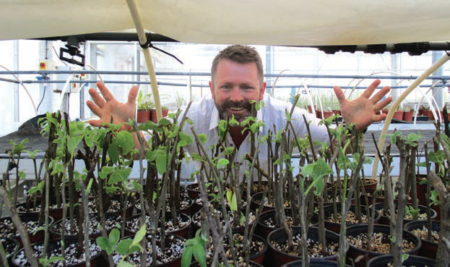
It is said that the gardener is part scientist, part artist, part philosopher, part ploughman. John R Whiting -1955. The curiosity of the plant world provides endless intrigue to the scientific mind. The rich palette of colour, form, and shape allows the gardener to express their artistic visions and flare; quietness, solitude and the changing seasons encourage the philosopher to wonder; connection to the soil through turning, grasping, smelling and observing makes a ploughman of the gardener. Since starting my career as horticulturalist and botanist I hold all of this to be true. 24 years working with plants has opened up
opportunities for learning, travel, people, wildlife, culture, creativity, and self-discovery. I am convinced no other career would have ever provided me with such a wealth of experience personal fulfillment.
So how did this journey begin? People ask, were you always interested in plants?
The truth of it is, no – not on any conscious level at least. Unaware of it at the time, my career began after leaving Ireland the early 1990s with high minded ideals of travel and adventure, picking up work here and there and moving on whenever it felt right. In retrospect, of course, it was a fanciful notion, the reality was a different matter. During this time I often found myself working in the horticultural trade – from picking flowers in the Netherlands to pruning roses in Israel, horticultural work kept me afloat and subconsciously set the scene for my future career.
After a number of years of this charmed life, I returned to Ireland with one burning question: what will I do now? Realising that I found great joy and curiosity from my time
working with plants, the answer seemed obvious. I set about finding out how to gain horticultural qualifications in Ireland. The three-year diploma in Amenity Horticulture,
which at the time was run by Teagasc at the National Botanic Gardens Glasnevin in Dublin, seemed like a good option. Not having the necessary experience to enter the Glasnevin course on my first attempt I undertook a 12-month horticulture course with FAS, which was a fantastic experience and fundamental to my successful application for the diploma course. The subsequent three years, which included a one-year placement at the RHS Garden Wisley in the UK, changed my life irrevocably and set me on a thoroughly rewarding path of personal development, learning, travel, and exposure to the absorbing world of plants, gardens and the broader natural world.
Without any doubt, the foundation of my career was set in the unique facilities and people at the NBG Glasnevin. The NBG Glasnevin like many botanic and large gardens are wonderful places of natural and constructed beauty, enormous botanical diversity, community, learning, and respite. As a student there I was immersed in these elements. Plants from around the world were at my fingertips and garden staff were always on hand to share their horticultural wisdom. I still remember the first botanical Latin name I heard; it was that doyen of suburban gardens, Griselinia littoralis. I was dumbfounded
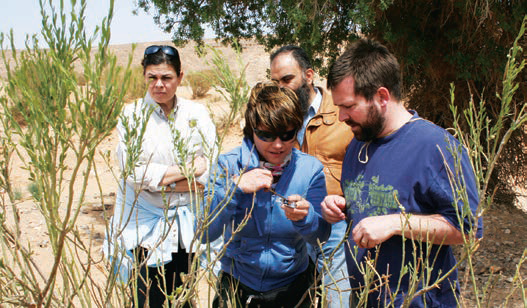
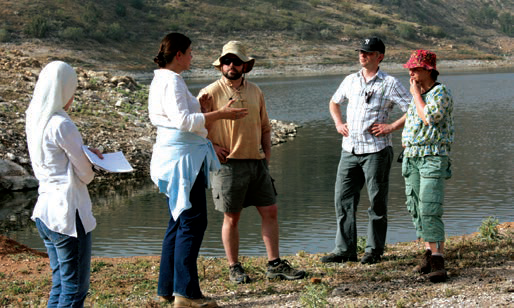
| Top left to right: NBG Glasnevin expedition – plant survey of Jordan (N. Smyth & D. Lupton) trying to identify Jordanian native plant species; Noeleen, Darach, Colin Kelleher and colleagues assessing habitat characteristics on the site of the Royal Botanic Garden Jordan – 2008; Pitcairn island nursery – 2005. N. Smyth, islanders who worked on the project and rare native tree seedlings; Maysa and N. Smyth taking time out from the sun on the NBG Glasnevin plant survey of Jordan; Photos: M. Jebb, J. Morris |
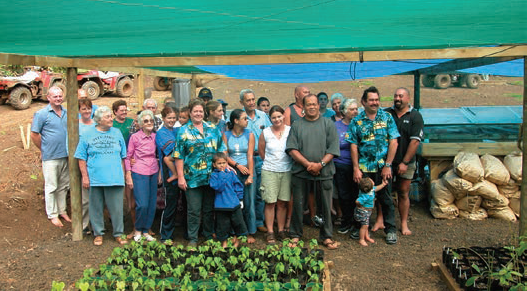
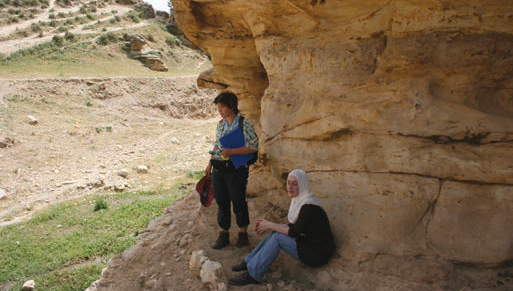
by this seemingly incomprehensible mouthful, how on earth was I going to remember that, never mind the 29 other equally tongue-twisting names I would have to learn and identify almost every week for the next three years? With time and experience, this task becomes less daunting. As students, we quickly became adept at identifying hundreds of plant species and cultivars. Leaf shape, texture, smell, flower colour and so on opened up a whole new world of detail and diversity. This early exposure to plants and knowledgeable gardeners was absolutely critical to fostering my enthusiasm. Without such a solid grounding I am sure things would have been far less fulfilling.
Over the last 24 years, including eight years of botanical undergraduate and postgraduate study, I have travelled and worked in many far-flung, exotic locations: collecting orchids in Belize, recording epiphytic ferns in Guyana, surveying tree ferns in Tanzania, collecting sedges in Cameroon, developing botanic gardens in Uganda, plant surveying in Jordan to my current role in Oman Botanic Garden as Senior Botanist and Curator of Living Collections. Everything can be attributed to the type of teaching, training, and experiences I was exposed to during my early years.
At the Oman Botanic Garden, we are documenting, collecting, propagating and cultivating the native plants of Oman. This ambitious and rewarding task has given me the opportunity to utilize the full breadth of the horticultural and botanical training I received in Ireland. Those early, terrifying plant identification exams, mentoring by helpful gardeners, the exposure to a wide variety of plant species, plant cultivation techniques and scientific observation and investigation have given me a very unique skill set which has allowed me to marry the practical and theoretical in such a useful and fulfilling way.
In the time since my student days, the emphasis on horticultural training in Ireland appears to have shifted away from developing a passion for plants, gardens and botanical diversity to a focused study of garden design and business management. There are individual exceptions to this but as whole this appears to be the trend. While this approach, of course, has its place I fear it is limiting the training and subsequent opportunities for the passionate Irish gardeners, horticulturalists, and botanists of the future. The rigorous immersive, plant-based training that I and many others were so lucky to receive must be re-emphasized in Irish horticultural training opportunities.
With re-emphasizing and reigniting the passion for and curiosity about plants I have no doubt that Ireland’s budding horticulturalists will make significant contributions to Irish and global horticulture. Horticulture is a wonderful, curious, rewarding and life-long profession that both enriches the individual and community. It promotes patience, observation, sharing, biodiversity, and a fascination with nature and directly improves the well-being of people and the planet. Good gardeners are essential. ✽
| DARACH LUPTON PhD., BA Mod. (Bot.), Dip. Hort. Senior Botanist & Curator of Living Collections Oman Botanic Garden, PO Box 808, PC 122 Sultanate of Oman Email: dluptonian@gmail.com |




